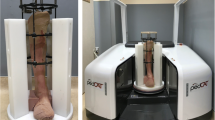Abstract
Objective
We aim to present a novel imaging technique utilizing weight-bearing CT with syndesmotic stress to identify subtle, unstable syndesmotic injuries. We illustrate this with a case presentation of such an injury in an elite athlete that ultimately required operative fixation.
Materials and methods
In order to perform an augmented stress weightbearing CT, the patient is in the standing position, feet facing forward, and with weight distributed equally. The patient is then coached to internally rotate the shin and knee. This places an external rotational moment on the TFS due to the planted foot and ankle. The augmented stress images undergo 3D reconstruction and post-processing to render coronal and sagittal images. These are subsequently compared to standard, conventional weightbearing CT images performed without the external rotation stress.
Results
We illustrate this technique by presenting a case in which a 21-year-old collegiate athlete sustained a Grade II syndesmotic injury, diagnosed by MRI and clinical exam without evidence of instability by standard weightbearing CT or weightbearing radiographs. After undergoing the augmented stress weightbearing CT, the instability was noted. This prompted subsequent operative fixation and ultimately return to sport.
Conclusion
We propose this technique for diagnosing unrecognized, subtle dynamically unstable syndesmosis injuries where clinical suspicion persists despite negative imaging, particularly in the elite athlete.









Similar content being viewed by others
References
Calder JD, Bamford R, Petrie A, McCollum GA. Stable versus unstable grade II high ankle sprains: a prospective study predicting the need for surgical stabilization and time to return to sports. Arthroscopy. 2016;32(4):634–42.
Wake J, Martin KD. Syndesmosis injury from diagnosis to repair: physical examination, diagnosis, and arthroscopic-assisted reduction. J Am Acad Orthop Surg. 2020;28(13):517–27.
Gerber JP, Williams GN, Scoville CR, Arciero RA, Taylor DC. Persistent disability associated with ankle sprains: a prospective examination of an athletic population. Foot Ankle Int. 1998;19(10):653–60.
D’Hooghe P, Grassi A, Alkhelaifi K, Calder J, Baltes TPA, Zaffagnini S, et al. Return to play after surgery for isolated unstable syndesmotic ankle injuries (West Point grade IIB and III) in 110 male professional football players: a retrospective cohort study. Br J Sports Med. 2020;54(19):1168–73.
Rammelt S, Zwipp H, Grass R. Injuries to the distal tibiofibular syndesmosis: an evidence-based approach to acute and chronic lesions. Foot Ankle Clin. 2008; 13(4):611–633, vii-viii
McCollum GA, van den Bekerom MP, Kerkhoffs GM, Calder JD, van Dijk CN. Syndesmosis and deltoid ligament injuries in the athlete. Knee Surg Sports Traumatol Arthrosc. 2013;21(6):1328–37.
Lui TH, Ip K, Chow HT. Comparison of radiologic and arthroscopic diagnoses of distal tibiofibular syndesmosis disruption in acute ankle fracture. Arthroscopy. 2005;21(11):1370.
Kellett JJ, Lovell GA, Eriksen DA, Sampson MJ. Diagnostic imaging of ankle syndesmosis injuries: a general review. J Med Imaging Radiat Oncol. 2018;62(2):159–68.
Oae K, Takao M, Naito K, Uchio Y, Kono T, Ishida J, et al. Injury of the tibiofibular syndesmosis: value of MR imaging for diagnosis. Radiology. 2003;227(1):155–61.
Takao M, Ochi M, Naito K, Iwata A, Kawasaki K, Tobita M, et al. Arthroscopic diagnosis of tibiofibular syndesmosis disruption. Arthroscopy. 2001;17(8):836–43.
Takao M, Ochi M, Oae K, Naito K, Uchio Y. Diagnosis of a tear of the tibiofibular syndesmosis. The role of arthroscopy of the ankle. J Bone Joint Surg Br. 2003;85(3):324–9.
Ahn TK, Choi SM, Kim JY, Lee WC. Isolated syndesmosis diastasis: computed tomography scan assessment with arthroscopic correlation. Arthroscopy. 2017;33(4):828–34.
Chang AL, Mandell JC. Syndesmotic ligaments of the ankle: anatomy, multimodality imaging, and patterns of injury. Curr Probl Diagn Radiol. 2020;49(6):452–9.
Barg A, Bailey T, Richter M, de Cesar NC, Lintz F, Burssens A, et al. Weightbearing computed tomography of the foot and ankle: emerging technology topical review. Foot Ankle Int. 2018;39(3):376–86.
Richter M, Seidl B, Zech S, Hahn S. PedCAT for 3D-imaging in standing position allows for more accurate bone position (angle) measurement than radiographs or CT. Foot Ankle Surg. 2014;20(3):201–7.
LaMothe JM, Baxter JR, Karnovsky SC, Murphy CI, Gilbert S, Drakos MC. Syndesmotic injury assessment with lateral imaging during stress testing in a cadaveric model. Foot Ankle Int. 2018;39(4):479–84.
Haller JM, Githens M, Rothberg D, Higgins T, Barei D, Nork S. Syndesmosis and syndesmotic equivalent injuries in tibial plafond fractures. J Orthop Trauma. 2019;33(3):e74–8.
Author information
Authors and Affiliations
Corresponding author
Ethics declarations
Conflict of interest
Megan R. Wolf
Arthrex: Direct payment for travel and/or courses
Stryker: Direct payment for travel and/or courses
Zimmer Biomet: Direct payment for travel and/or courses
Paragon28: Direct payment for travel and/or courses
Artelon: Direct payment for travel and/or courses
Bryan G. Vopat MD
Altior: Stock or stock Options
American Orthopaedic Foot and Ankle Society: Board or committee member
Artelon: Paid consultant
Carbon 22: Stock or stock Options
Spinal Simplicity: Stock or stock Options
Additional information
Publisher's note
Springer Nature remains neutral with regard to jurisdictional claims in published maps and institutional affiliations.
Rights and permissions
Springer Nature or its licensor (e.g. a society or other partner) holds exclusive rights to this article under a publishing agreement with the author(s) or other rightsholder(s); author self-archiving of the accepted manuscript version of this article is solely governed by the terms of such publishing agreement and applicable law.
About this article
Cite this article
Campbell, T., Mok, A., Wolf, M.R. et al. Augmented stress weightbearing CT for evaluation of subtle tibiofibular syndesmotic injuries in the elite athlete. Skeletal Radiol 52, 1221–1227 (2023). https://doi.org/10.1007/s00256-022-04229-9
Received:
Revised:
Accepted:
Published:
Issue Date:
DOI: https://doi.org/10.1007/s00256-022-04229-9




